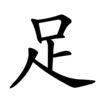足
| ||||||||
Translingual
| Stroke order | |||
|---|---|---|---|
 | |||
Alternative forms
The combining form of this character, ⻊/𧾷, is encoded at two Unicode code points as U+2ECA CJK RADICAL FOOT and U+27FB7 CJK UNIFIED IDEOGRAPH-27FB7 respectively.
Han character
足 (radical 157, 足+0, 7 strokes, cangjie input 口卜人 (RYO), four-corner 60801, composition ⿱口龰)
- Kangxi radical #157, ⾜.
Derived characters
- Index:Chinese radical/足
References
- KangXi: page 1221, character 17
- Dai Kanwa Jiten: character 37365
- Dae Jaweon: page 1692, character 29
- Hanyu Da Zidian: volume 6, page 3686, character 1
- Unihan data for U+8DB3
Chinese
| simp. and trad. |
足 | |
|---|---|---|
| variant forms | 𠯁 𠯣 | |
Glyph origin
| Historical forms of the character 足 |
|---|
| Shuowen Jiezi (compiled in Han) |
| Small seal script |
 |
| Characters in the same phonetic series (足) (Zhengzhang, 2003) | |
|---|---|
| Old Chinese | |
| 足 | *ʔsoɡs, *ʔsoɡ |
| 莡 | *sʰaːwɢ |
| 捉 | *ʔsoːɡ |
| 齪 | *sʰroːɡ, *sʰruɡ |
| 娖 | *zroːɡ |
| 浞 | *zroːɡ |
| 鋜 | *zroːɡ |
| 趗 | *sʰoːɡ, *sʰoɡ |
| 珿 | *sʰruɡ |
| 哫 | *ʔsoɡ |
| 促 | *sʰoɡ |
Pronunciation 1
Definitions
足
- (anatomy) foot
- (anatomy) leg (of an animal)
- leg (of an object)
- to walk
- to tread; to stamp; to step
- to satisfy; to fulfil
- to stop; to cease
- enough; sufficient; not lacking
- abundant; affluent
- to be worthy of; to warrant
- fully; entirely
- (Zhangzhou and Taiwanese Hokkien) very; quite
- can; may
- A surname.
Synonyms
| Dialectal synonyms of 很 (“very; quite”) [map] | ||
|---|---|---|
| Variety | Location | Words |
| Classical Chinese | 甚 | |
| Formal (Written Standard Chinese) | 非常, 很, 十分, 太 | |
| Mandarin | Beijing | 挺, 很, 倍兒 |
| Taiwan | 很, 挺 | |
| Tianjin | 挺, 很 | |
| Jinan | 挺, 楞 | |
| Xi'an | 很 | |
| Wuhan | 蠻, 很 | |
| Chengdu | 很, 好 | |
| Yangzhou | 蠻, 稀, 很 | |
| Hefei | 很 | |
| Cantonese | Guangzhou | 好 |
| Hong Kong | 好 | |
| Taishan | 好 | |
| Yangjiang | 好 | |
| Gan | Nanchang | 蠻 |
| Hakka | Meixian | 好 |
| Miaoli (N. Sixian) | 當, 已, 還 | |
| Liudui (S. Sixian) | 蓋, 盡, 還 | |
| Hsinchu (Hailu) | 當, 已, 還 | |
| Dongshi (Dabu) | 當, 已, 還 | |
| Hsinchu (Raoping) | 當, 已, 還 | |
| Yunlin (Zhao'an) | 足, 真, 實在 | |
| Sabah | 好 | |
| Jin | Taiyuan | 很, 挺 |
| Min Bei | Jian'ou | 真 |
| Min Dong | Fuzhou | 野, 真 |
| Min Nan | Xiamen | 真, 野, 誠, 有夠 |
| Quanzhou | 真, 野, 誠, 有夠 | |
| Zhangzhou | 盡, 蓋, 足, 足範, 有夠, 出奇, 極死, 見死 | |
| Taipei | 真, 誠 | |
| Kaohsiung | 有夠, 足, 真, 誠, 蓋 | |
| Tainan | 有夠, 足, 真, 誠, 蓋 | |
| Taichung | 誠, 蓋, 足 | |
| Hsinchu | 真, 誠 | |
| Lukang | 真, 誠 | |
| Sanxia | 真, 誠 | |
| Yilan | 有夠, 足, 誠, 盡 | |
| Kinmen | 足, 誠 | |
| Magong | 真, 誠 | |
| Penang | 真, 誠, 真正 | |
| Philippines (Manila) | 野, 真 | |
| Chaozhou | 過 | |
| Wu | Shanghai | 蠻, 老 |
| Suzhou | 蠻 | |
| Wenzhou | 蠻, 蒙, 顯 | |
| Xiang | Changsha | 很, 蠻 |
| Shuangfeng | 蠻 | |
Compounds
Derived terms from 足
|
|
|
Pronunciation 2
Japanese
Readings
Compounds
Compounds
- 足掻き (agaki): pawing
- 足跡 (ashiato): footprint
- 足音 (ashioto): sound of footsteps
- 足掛かり (ashigakari): foothold
- 足首 (ashikubi): ankle
- 足取り (ashidori): gait, trace
- 足白癬 (ashihakusen): athlete's foot
- 足早 (ashibaya): briskness, swift-footedness, fast-pacedness
- 足元 (ashimoto): near or at one's feet
- 足袋 (tabi): tabi
- 豚足 (tonsoku): pig's trotters
Pronunciation
Alternative forms
Okinawan
Kanji
足
- Native: あし (ashi), ふぃさ (fisa)
- Nonnative: すく (suku)
Compounds
- 寝んじ不足 (にんじぶすく, ninjibusuku, “lack of sleep, sleep deprivation”)
Pronunciation
- IPA(key): /ɸisa/
Derived terms
- 足甲 (ふぃさなー, fisanā, “top of the foot”)
Pronunciation
- IPA(key): /ʔaɕi/
Derived terms
- 足てぃびち (あしてぃびち, ashitibichi, “pig's feet soup”)
References
- 1896: 沖縄語典 (Okinawa Goten, “Okinawan Dictionary”). In Japanese. http://kindai.ndl.go.jp/info:ndljp/pid/992016/13
Vietnamese
Han character
足 (túc)
- This term needs a translation to English. Please help out and add a translation, then remove the text
{{rfdef}}.
This article is issued from
Wiktionary.
The text is licensed under Creative
Commons - Attribution - Sharealike.
Additional terms may apply for the media files.